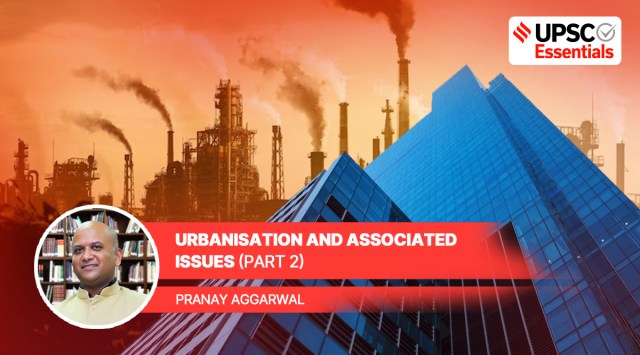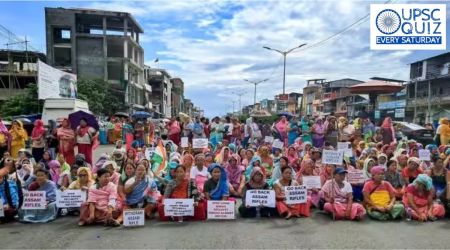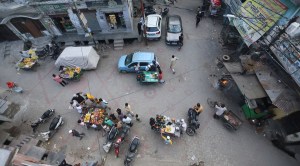UPSC Essentials | Society & Social Justice : Urbanisation and associated issues (Part 2)
Rurbanisation, urban floods, and more — Pranay Aggarwal discusses key issues and probable questions for UPSC CSE on Urbanisation. Don't miss 'Express Inputs', and stay tuned for Part 3.
 "The concept of rurbanisation has gained attention in academic papers and discussions due for several reasons," says Pranay Aggarwal
"The concept of rurbanisation has gained attention in academic papers and discussions due for several reasons," says Pranay Aggarwal (In UPSC Essentials’ series ‘Society & Social Justice’, which we have started for social issues topics of UPSC CSE, our subject experts will give an overview of the theme from both, static and dynamic points of view. ‘Express Inputs’ will widen your horizon on the issue. For the month of August, we take up the topic of ‘Urbanisation and associated issues’. In part 1, Pranay Aggarwal in conversation with Manas Srivastava talked about the definition, process, positive and negative impacts, and more. He also addresses a past UPSC question related to the topic. In part 2, he talks about rurbanisation, social effect of urbanisation, urban floods, and more. He also guides on how to write an introduction to such a topic)
About the Expert: Pranay Aggarwal is an educator and mentor for aspirants preparing for UPSC Civil Services Examination. With more than 10 years of experience guiding civil service aspirants, he is acknowledged as an expert on civil service exam preparation especially on subjects such as Social Issues and Sociology. He is the India representative on Research Committee on Education for UNESCO’s International Sociological Association and a member of Indian Sociological Society’s committee on social movements. He is also the Convenor of Indian Civil Services Association, a think tank of senior bureaucrats.
Relevance of the topic: With the increasing pace of urbanisation along with the baggage of problems seen in recent times, this topic becomes essential for UPSC preparation. It is an important theme in GS I (Society), GS II, GS III, Prelims and Personality test. Aspirants will find it relevant for Essays as well. You are advised to go through the part 1 before reading this part.
Manas: ‘Rurbanisation’ is a common term in academic papers, what is it and why is it being discussed?
Pranay Aggarwal: The word rurban can be understood as rural+urban. One may simply define it as a geographical landscape that possesses the characteristics like the economic ones and lifestyles of an urban area. However, essentially retains some of its prominent rural characteristics.
The term was coined in 1918 by Charles Galpin, a pioneer of rural sociology in America, and popularised by Sorokin in his 1929 book Principles of Rural-Urban Sociology. Then in 1949, Parsons explored the idea of rurbanisation in his book ‘Essays in Sociological Theory’. According to Parsons, rurban communities are the rural socio-geographic spaces where styles of life and the standard of living have changed so much that they resemble those in urban localities.
There may be two reasons for Rurbanisation: urban expansion or rural migration. According to Arthapedia, this change is made possible through urban – rural interactions, including the accumulation of capital/ remittances and exposure to Western/ modern ideas and lifestyles that eventually build new mindsets.
The concept of rurbanisation has gained attention in academic papers and discussions due for several reasons:
1. Changing Rural-Urban Dynamics: Rurbanisation reflects the changing dynamics between urban and rural areas. Traditionally, rural areas were associated with agriculture and primary activities, while urban areas were centers of industry, commerce, and services.
However, with the advent of modernisation, technological advancements, and improved transportation, rural areas are experiencing the influence of urbanization. This includes the penetration of urban lifestyles, infrastructure development, and the diversification of economic activities.
2. Urban Influence on Rural Areas: Rurbanisation highlights the impact of urbanization on rural areas. As urban areas expand and extend their reach, they exert influence on neighboring rural areas. This influence can be observed in terms of infrastructure development, access to services, changes in land use patterns, and adoption of urban practices. Rurbanisation represents a blending of urban and rural characteristics in these areas.
3. Urban-Rural Linkages: Rurbanisation emphasizes the interconnectedness and interdependence between urban and rural areas. It recognises that rural and urban areas are not isolated entities but are closely connected through economic, social, and environmental linkages. Rurban areas often serve as transition zones, where rural populations engage in non-agricultural activities, benefit from urban services, and participate in the urban economy.
4. Diversification of Rural Economy: Rurbanisation signifies the diversification of the rural economy beyond traditional agricultural activities. With the expansion of infrastructure, communication networks, and market integration, rural areas are witnessing the emergence of non-farm activities such as small-scale industries, tourism, services, and knowledge-based activities. This diversification contributes to rural development, employment generation, and improved living standards.
5. Policy Implications: Rurbanisation raises important policy considerations for governments and policymakers. It calls for a reevaluation of urban and rural development strategies and the need for integrated approaches. Addressing the challenges and opportunities associated with rurbanisation requires policies that balance the preservation of rural identity and livelihoods with the provision of urban amenities and services. Understanding rurbanisation is essential for policymakers, planners, and researchers to effectively address the evolving dynamics of rural and urban areas. It enables the development of strategies that promote sustainable rural-urban linkages, balanced regional development, and inclusive growth, considering the unique characteristics and needs of rurban areas.
Manas: Speaking sociologically; how has urbanisation affected family, caste, women, village life and other social institutions?
Pranay Aggarwal: Urbanisation has had profound sociological effects on various aspects of society, including family structures, caste dynamics, women’s roles, village life, and social institutions. Let’s explore each of these areas:
1. Family Structures: Urbanisation has influenced changes in family structures. Traditional extended families, where multiple generations lived together, have given way to nuclear families due to urban living constraints and changing social norms. The urban environment, with its emphasis on individualism and mobility, has led to increased autonomy and decision-making power for individuals within families. This shift in family structures has implications for inter generational relationships, care giving arrangements, and support systems.
2. Caste Dynamics: Urbanisation has had complex effects on caste dynamics. In rural areas, caste identities tend to be deeply entrenched, shaping social interactions, occupational opportunities, and access to resources. In urban areas, the impact of caste may be somewhat diluted due to increased social mixing, anonymity, and the dominance of market forces. However, caste-based discrimination and inequalities can persist in urban settings, albeit in different forms. Urbanisation also offers opportunities for social mobility, as individuals may experience greater economic and educational opportunities that transcend traditional caste boundaries.
3. Women’s Roles: Urbanisation has brought significant changes in the roles and status of women. Urban areas often provide greater access to education, employment, and opportunities for women’s empowerment. Women in urban areas have more exposure to diverse ideas, greater economic independence, and increased participation in non-traditional roles and professions. However, urbanisation can also present challenges for women, including issues of safety, work-life balance, and gender-based discrimination. Urbanisation has catalyzed discussions and movements for women’s rights, gender equality, and empowerment.
4. Village Life: Urbanisation has transformed village life in various ways. As people migrate from rural to urban areas, villages experience changes in population demographics, economic activities, and social structures. The outflow of working-age individuals can lead to labor shortages in agricultural and allied sectors, impacting rural livelihoods. Urbanisation can also lead to changes in traditional occupations, land-use patterns, and cultural practices. However, urbanisation has also contributed to the flow of remittances, knowledge, and technology from urban areas to villages, facilitating rural development.
5. Other Social Institutions: Urbanisation has had significant impacts on other social institutions such as education, healthcare, governance, and community organisations. Urban areas offer better access to educational institutions, leading to increased literacy rates and educational attainment. Urbanisation has facilitated the
development of healthcare infrastructure, specialized medical services, and improved health outcomes. The urban environment has also influenced the functioning of governance structures, with increased emphasis on urban planning, service delivery, and citizen participation. Social organisations and community networks may undergo
transformation as urban areas present different social dynamics and modes of engagement.
It is important to note that the effects of urbanisation on these aspects of society are diverse and complex, varying across different regions, socio-economic groups, and cultural contexts. Sociological studies play a crucial role in understanding these effects and informing policies and interventions that address the challenges and capitalise on the opportunities presented by urbanisation.
Manas: Monsoons, as usual, brought many challenges. What should we know about urban floods? What is the link between urban flooding, sustainability, and development?
Pranay Aggarwal: Urban flooding is a major issue across India. As citizens, we are well aware of the annual news of city life in Mumbai coming to a grinding halt; the choking of Delhi drainage systems, and the sinking of Himalayan cities. Administrations from Delhi-NCR, Punjab, Haryana, and Himachal Pradesh had to shut down schools due to heavy rains, and several lives were lost to heavy downpours in Uttar Pradesh, Uttarakhand, and Jammu & Kashmir.
Urban floods refer to the flooding of urban areas, typically caused by heavy rainfall overwhelming the drainage systems and infrastructure in cities. When precipitation exceeds the capacity of drainage systems to handle it, water accumulates on streets, in residential areas, and in public spaces, leading to property damage, disruption of essential services, and threats to public safety.
In the Indian context, monsoons play a crucial role in shaping the urban environment. Indian cities experience a significant impact from monsoons due to their geographical location and infrastructure vulnerabilities. The impact of monsoons on Indian cities is both positive and negative. On one hand, monsoons provide essential water resources for replenishing reservoirs, recharging groundwater tables and supporting ecosystems. On the other hand, the intensity and duration of rainfall during the monsoon season can result in urban floods and associated problems.
The linkage between urban floods, sustainability, and development is significant. Urban floods can have detrimental effects on the sustainability and development of cities in the following ways:
1. Infrastructure and Environmental Damage: Urban floods can cause damage to infrastructure such as roads, bridges, buildings, and utilities. This leads to economic losses, hampers transportation systems, disrupts essential services, and affects the overall functioning of the city. Additionally, urban floods can result in environmental damage, including contamination of water sources and loss of bio-diversity.
2. Public Health Risks: Urban floods can pose significant risks to public health. Waterborne diseases, vector-borne illnesses, and contamination of water supplies are common consequences of urban flooding. Poor sanitation and lack of access to clean water during flood events increase the vulnerability of the population to health hazards.
3. Social Disruption and Vulnerability: Urban floods disproportionately affect marginalised and vulnerable communities. These communities often reside in low-lying areas, informal settlements, or areas prone to flooding. The lack of adequate infrastructure and basic services in these areas exacerbates their vulnerability to the impacts of urban floods, resulting in social disruption and exacerbating inequalities.
4. Sustainable Development Goals (SDGs): Urban floods directly intersect with several SDGs, including SDG 11 (Sustainable Cities and Communities) and SDG 13 (Climate Action). Effective management and mitigation of urban floods contribute to building resilient cities, ensuring access to safe and sustainable infrastructure, and promoting climate adaptation strategies.
To address the linkage between urban floods, sustainability, and development, cities need to focus on sustainable urban planning, climate-resilient infrastructure, and effective flood management strategies. This includes investment in robust drainage systems, flood-resistant building designs, green infrastructure, early warning systems, and community-based flood preparedness.
Manas: Students face a challenge in writing a good introduction, including for topics like urbanisation. Your suggestion?
Pranay Aggarwal: What makes for an impactful introduction will depend on what you intend to emphasise in your essay. Ensure that your introduction hovers around the essay topic and elaborates upon what you wish to highlight.
For instance, to emphasise the importance of cities, begin something like this:
“Throughout human history, cities stand as vibrant hubs pulsating with energy, innovation, and human connection. From ancient civilizations to modern metropolises, cities have been the epicenters of progress, culture, and transformation. As we navigate the vast complexities of urban life, it becomes evident that cities hold a profound significance in shaping our collective destiny.”
For an essay on urban problems, one could begin something like this:
“Beneath the dazzling façade of towering skyscrapers and bustling streets, lies a complex web of challenges. As humanity increasingly gravitates towards cities, drawn by the promises of opportunities and modernity, we find ourselves confronted with a range of issues that demand our attention and collective resolve. That challenge is of urban life.”
Alternatively, one could begin with a specific urban issue experienced by many, say loneliness and isolation, as follows:
“In the bustling streets of the cities, an epidemic of isolation quietly thrives. Behind the facade of instant connectivity and constant activity, city dwellers find themselves trapped in a paradoxical state of loneliness. As we navigate life in the concrete jungle, it becomes increasingly evident that the fast-paced nature of urban living has erected invisible walls that isolate individuals and erode the very fabric of human connection.”
For an essay on urban governance, consider the below introduction:
“In the ever-evolving urban landscapes, the concept of governance emerges as the invisible hand that steers the trajectory of cities. Urban governance serves as the compass guiding the decisions, policies, and actions that shape the very fabric of our urban existence. As cities grow in size and complexity, the importance of effective urban governance becomes all the more pronounced.”
EXPRESS INPUT
Point to ponder: When it pours it floods: Why our cities fail the rain test
Record rains, swollen rivers, submerged homes, loss of lives and livelihoods, and traffic jams – cities and towns across the country come to a halt every monsoon. But why is it that our cities can’t handle rains, and what is the way forward? The Indian Express spoke to urban planning experts across cities. Let’s dive deep into the following article by Shiny Varghese.
Aug 14: Latest News
- 01
- 02
- 03
- 04
- 05
































